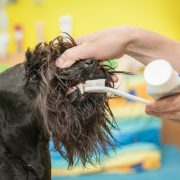Antimicrobial use guidelines for canine pyoderma by the International Society for Companion Animal Infectious Diseases (ISCAID)
Antimicrobial use guidelines for canine pyoderma by the International
Society for Companion Animal Infectious Diseases (ISCAID)

Open access
In our edition of: Aug 2025
In our categories of: small animals
our summary:
Loeffler, A. et al. (2025) Antimicrobial use guidelines for canine pyoderma by the International Society for Companion Animal Infectious Diseases (ISCAID). Veterinary Dermatology, 36 (3), pp 234–282.
The aim of these consensus guidelines was to provide was to provide clinicians with recommendations for managing canine pyoderma which optimise treatment outcomes while promoting responsible antimicrobial use.
The guidelines are based on a review of the available literature with recommendations based on the consensus opinion of the panel of authors and feedback from a panel of general practitioners and specialists. The quality of evidence from published therapeutic trials was assessed using the Strength of Recommendation Taxonomy
The guidelines start by discussing types of canine pyoderma and bacterial pathogens; approaches to diagnosis and tests, with a three -step approach of skin examination, cytology and investigations into underlying cause recommended, and bacterial culture and antimicrobial susceptibility testing (BC/AST). The following sections then cover surface pyoderma, superficial pyoderma and deep pyoderma, for each of these clinical presentation, diagnosis, and treatment options are covered. The final sections discus topical antimicrobial therapy, systemic antimicrobial therapy, preventing recurrence of pyoderma, and meticillin-resistant staphylococcal pyoderma. An index at the start of the guidelines makes navigating through the sections easier.
Recommendations include that topical antimicrobial therapy is the treatment of choice for surface and superficial pyodermas, and that combination therapy of topical antimicrobial therapy with topical glucocorticoids or with a short course of systemic glucocorticoids may be helpful in cases of pyotraumatic dermatitis and of intertrigo where an inflammatory or pruritic primary cause is involved; systemic antimicrobials should be reserved for deep pyoderma and for superficial pyoderma when topical therapy is not effective, that at a minimum cytology should be performed in all cases before antimicrobials are used, and where systemic antibacterial therapy is used for deep pyoderma the choice of drug should always be based on BC/AST results.
The guidelines would benefit from clearer signposting of both the recommendations and the associated Strength of Recommendation grading where available.
These guidelines provide practitioners with an overview of the current knowledge on the management of canine pyoderma and provides example approaches for specific scenarios. The information provided will also help practitioners select and use antimicrobials responsibly
The following may also be of interest:
In the Spotlight: Responsible us of antibiotics in veterinary practice: guidelines recommendations: companion animals [RCVS Knowledge] [Online] Available from: https://infocus.rcvsknowledge.org/amr_responsible-use-of-antibiotics-guidelines-and-recommendations-companion-animals/ [Accessed 24 August 2025]
PROTECT ME: Responsible antibacterial use in the veterinary community [BSAVA] [Online] Available from: https://www.bsava.com/Resources/Veterinary-resources/PROTECT-ME/ [Accessed 24 August 2025]
Claiming CPD for reading inFOCUS articles
Reading and reflecting on articles can count towards your CPD, and we have a template to help you with the process.
Image copyright attribute: seventyfour74







Leave a Reply
Want to join the discussion?Feel free to contribute!